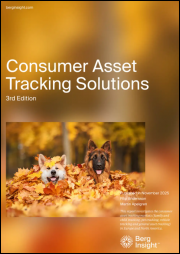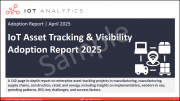
|
시장보고서
상품코드
1697452
IoT 자산 추적 및 시각화 : 도입 보고서(2025년)IoT Asset Tracking & Visibility Adoption Report 2025 |
||||||
이 보고서는 IoT Analytics가 지속적으로 발행하는 다음 조사 보고서의 일부이며 제조업, 소매업 및 건설업에 자산 추적 솔루션을 도입하는 기업 100개를 대상으로 하는 광범위한 조사를 기반으로 합니다.
이 보고서는 IoT Analytics의 데이터 중심 시장 조사 출판물입니다. IoT 기반 자산 추적 및 시각화 솔루션의 실제 채용 상황을 조사했습니다. 의사결정자 100명을 대상으로 한 조사를 바탕으로 GPS, RFID, IoT 센서 등의 기술을 사용하여 기업이 물리적 자산을 추적하는 방법을 조사했습니다. 도입 수준, 추적 대상 자산 유형, 공급업체 참여, 업계 횡단 지출 패턴을 공개하고 C 수준 경영진과 전략 담당자에게 벤치마킹을 위한 종합적인 참조 포인트를 제공합니다.
SAMPLE VIEW
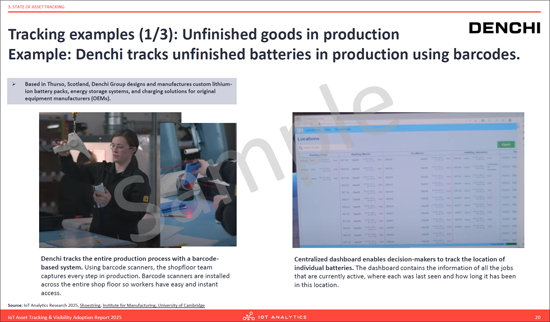
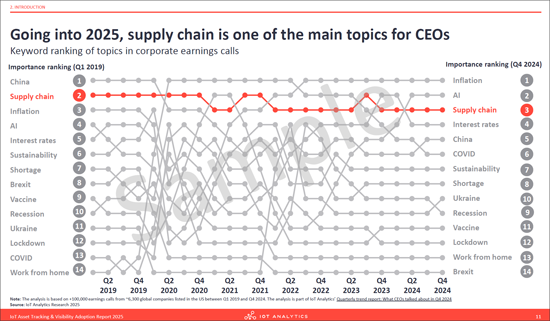
SAMPLE VIEW
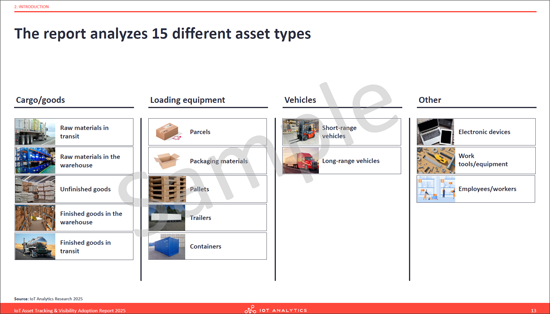
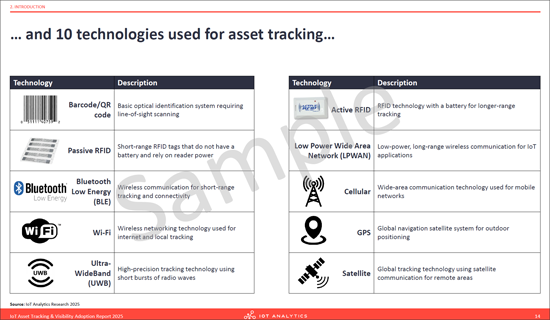
답변된 질문:
- 가장 추적되는 자산은 무엇이며 각 자산에 대해 무엇이 추적되고 있는가?
- 자산 추적 솔루션으로 어떤 이용 사례가 가능합니까?
- 가장 많이 사용되는 추적 기술은 무엇이며 추적 솔루션과 통합되는 기업 시스템은 무엇인가?
- 도입된 솔루션의 확장성 및 통합성, 데이터 전송 및 분석 방법은?
- 가장 이용되고 있는 벤더와 그 고객 만족도는?
- 시장에서 개별 공급업체의 강점과 약점은 무엇인가?
- 도입 기업은 어떻게 자산 추적 솔루션을 선택합니까?
- 도입시 어떤 과제에 직면했는지, 또 도입 성공의 비결은 무엇인가?
- 기업은 도입에서 어떤 ROI를 얻었는지, 그리고 기대에 어떻게 대응했는가?
- 2025년에는 어떤 전개가 예상되는가?
게시 기업
|
|
|
|
목차
제1장 주요 요약
제2장 소개
제3장 자산 추적의 현상
- 1. 개요 및 중요 포인트
- 2. 자산 추적 개요
- 3. 의약품 및 식음료 업계의 자산 추적 촉진요인 : 콜드체인
- 4. 추적 대상 자산의 유형
- 5. 추적 예 : 생산 중 미완성품
- 6. 추적 예 : 직원 및 근로자
- 7. 추적 예: 소포
- 8. 추적 대상 자산의 수
- 9. 자산 속성 추적
- 10. 온도 추적
- 11. 사용 상황의 추적
- 12. 자산 추적 이용 사례 : 전체
- 13. 자산 추적 이용 사례 : 자산 유형별
- 14. 자산 추적 이용 사례 : 지역별, 기업 규모별
- 15. 자산 추적 이용 사례 : 업계별
제4장 기술 통찰
- 1. 개요 및 중요 포인트
- 2. 접속 기술 : 개요
- 3. 접속 기술 : 자산 유형별
- 4. 운송 컨테이너 추적 : Hapag Lloyd는 위성과 휴대폰 기술을 결합하여 사용
- 5. 자산 추적을 지원하는 소프트웨어 및 플랫폼: 개요
- 6. 자산 추적을 지원하는 소프트웨어 및 플랫폼: 자산 유형별
- 7. 플랫폼 예: SAP ERP에 통합
- 8. 플랫폼 예: Oracle의 EAM 자산 관리 솔루션
- 9. 플랫폼 예: Verizon의 플릿 관리 솔루션 Connect Reveal
- 10. 기술 하이라이트 : 개요
- 11. 기술 심층분석 : 자산 추적 솔루션의 확장성
- 12. 기술 심층분석 : 기업 시스템과의 통합
- 13. 추적 프로젝트의 성공에 영향을 미치는 통합
- 14. 기술 심층분석 : 데이터 전송 주파수
- 15. 추적 프로젝트의 성공에 영향을 미치는 데이터 전송 주파수
- 16. 기술 심층분석 : 자산 추적 데이터의 긴급성 분석
제5장 벤더의 통찰
- 1. 개요 및 중요 포인트
- 2. 가장 많이 언급된 자산 추적 벤더 10개사: 개요
- 3. 가장 많이 언급된 자산 추적 벤더 10개사: 만족도와 기대
- 4. 가장 많이 언급된 자산 추적 벤더 10개사: 추적 대상 자산별
- 5. 응답자가 거래한 모든 벤더의 상세한 목록
- 6. 주요 벤더의 연결 기술과 제공 하드웨어
- 7. 개요 : 벤더의 강점과 약점
- 8. 의견 심층분석 : 벤더의 강점
- 9. 의견 심층분석 : 벤더의 약점
- 10. 의견 심층분석 : 벤더 : SAP, 사내, Oracle
- 11. 의견 심층분석 : 벤더 : IBM, Microsoft, Honeywell, Zebra, Samsara
- 12. 의견 심층분석 : 벤더 : Verizon, Project44, Asset Panda
제6장 촉진요인, 성공 요인, 과제
- 1. 개요 및 중요 포인트
- 2. 개요 : 자산 추적 구현의 촉진요인과 의사 결정 기준
- 3. 자산 추적 솔루션의 주요 의사 결정 기준 : 지역, 업계, 기업 규모별
- 4. 자산 추적 솔루션의 주요 의사 결정 기준 : 상세 산업별
- 5. 의사결정 기준의 상세 : 개요
- 6. 예 : 자산 추적 솔루션 비용
- 7. 예 : 기존 시스템에 데이터 통합
- 8. 의사결정 기준의 상세 : 지역, 업종, 규모별
- 9. 의사 결정 기준 심층분석 : 상세 업계별
- 10. 자산 추적 솔루션을 구현할 때의 목표 : 개요
- 11. 자산 추적 솔루션 도입의 목적 : 상세 산업별
- 12. 예: 특정 기업이 자산 추적 목표를 달성한 방법
- 13. 자산 추적 구현의 과제: 개요
- 14. 자산 추적 구현의 과제: XX
- 15. 지출, ROI 및 2025년의 사업 전망 : 개요 및 주요 포인트
- 16. 자산 추적 지출 : 개요
- 17. 자산 추적 지출 : 자산 유형별
- 18. 자산 추적 지출 : 상세 산업별
- 19. 자산 추적 솔루션 ROI : 개요
- 20. 자산 추적 솔루션 ROI : 부문별, 추적 대상 자산별
- 21. 자산 추적 솔루션 ROI가 높은 이유
제7장 지출, ROI 및 2025년의 사업 전망
- 1. 자산 추적의 구현 결과 : 개요
- 2. 자산 추적의 구현 결과 : 부문별 및 자산 유형별
- 3. 자산 추적의 구현 결과 : 자산 유형별 상세
- 4. 2025년 지출 전망 : 개요
- 5. 2025년 지출 전망 : 상세 업종별
- 6. 2025년 지출 전망 : 자산 유형별
- 7. 지출 증가의 5가지 주요 요인(응답자의 코멘트에 기초)
- 8. 지출 증가의 이유
제8장 조사 방법
제9장 부록
제10장 IoT Analytics 정보
JHS 25.04.17A 142-page report on enterprise asset-tracking projects in manufacturing, mfg. supply chains, construction, retail, energy, incl. insights on implementation, vendors in use, spending patterns, ROI, challenges, and success factors.
The "IoT Asset Tracking & Visibility Adoption Report 2025" is part of IoT Analytics' ongoing coverage of the IoT in general. The information presented in this report is based on an extensive survey of 100 adopters of asset-tracking solutions in the manufacturing, retail, and construction industries. The purpose is to inform other market participants about the current state of asset tracking across companies. Survey participants were selected randomly, and their knowledge was verified independently. To ensure complete objectivity, IoT Analytics did not alter or supplement any survey results and did not accept participants who were suggested by third parties (e.g., customers from specific vendors)-and where it's heading.
SAMPLE VIEW


Understand the current state of IoT asset tracking adoption
The "IoT Asset Tracking & Visibility Adoption Report 2025" is a data-centric market research publication by IoT Analytics. It explores the real-world adoption of IoT-based asset tracking and visibility solutions. Based on a global survey of 100 qualified decision-makers, the report investigates how companies track physical assets using technologies like GPS, RFID, and IoT sensors. It highlights adoption levels, tracked asset types, vendor involvement, and spending patterns across industries, offering C-level executives and strategists a comprehensive reference point for benchmarking.
SAMPLE VIEW


Structured analysis across key areas of asset tracking
The report is organized into clearly defined chapters, each covering a specific aspect of IoT-based asset tracking and visibility adoption:
- Executive summary. Highlights of the key findings and conclusions from the survey analysis.
- Introduction. Context and definitions, including the scope of asset types, environments, and visibility goals.
- State of asset tracking. Examines which assets are tracked, how many, which attributes are monitored, and the implementation footprint across use cases.
- Technology insights. Reviews tagging technologies, connectivity protocols, software platforms, integration levels, and data transmission frequency.
- Vendor insights. Details which solution providers are used, customer satisfaction levels, and vendor strengths/weaknesses.
- Drivers, success factors & challenges. Covers project goals, implementation bottlenecks, and best practices.
- Spending, ROI & business outlook 2025. Discusses current and planned investment levels, ROI findings, and future expectations.
- Methodology and appendix. Outlines survey methodology, respondent demographics, and additional charts.
Insights into what companies are doing in the field
The report provides a detailed snapshot of how companies are applying IoT-based asset tracking today. Based on end-user input, it allows market participants to understand what is being tracked, how it is being tracked, and why:
- Asset types and tracked data. Understand which assets are being monitored and what attributes-like location, temperature, or vibration-are tracked by end-users.
- Scale of deployment. See how many assets are currently tracked per type and what share of total assets companies aim to monitor in full rollouts.
- Technology and integration. Learn which connectivity technologies and sensor types are used in practice, how often data is transmitted, and how tracking systems are integrated into enterprise platforms like ERP or inventory management.
- Software and use cases. Discover which software platforms support tracking and what use cases-such as theft prevention, predictive maintenance, or inventory optimization-are actively enabled by users.
- Vendor landscape. Identify which solution providers are being used, what parts of the solution they deliver, and how satisfied users are with their performance.
- Spending and ROI. Benchmark how much companies are spending annually, how budgets are expected to change in 2025, and what levels of ROI are achieved across asset types.
- Implementation realities. Gain insight into how end-users select solutions, handle time-sensitive data, overcome deployment challenges, and what they cite as key success factors.
A downloadable sample of the report is available to preview the structure, explore example insights, and assess the data depth. It provides a grounded foundation for organizations looking to benchmark or plan their IoT asset tracking initiatives.
Questions answered:
- Which are the most tracked assets and what is being tracked for each asset?
- Which use cases are enabled from asset-tracking solutions?
- Which are the most used tracking technologies, and which company systems are integrated with the tracking solution?
- How scalable/integrated are the implemented solutions, and how is the data transmitted/analyzed?
- Which are the most used vendors, and how satisfied are their customers?
- What are the strengths and weaknesses of individual vendors in the market?
- How are adopters selecting asset-tracking solutions?
- What challenges did they face when implementing, and what tips do they have for a successful implementation?
- What ROI have companies seen from their implementations, and how did this meet their expectations?
- How much are companies spending on asset tracking and how is that spending expected to develop in 2025?
Companies mentioned:
A selection of companies mentioned in the report.
|
|
|
|
Table of Contents
1. Executive Summary
2. Introduction
- 1. What is Asset Tracking in the context of this report
- 2. Asset tracking plays a crucial role in companies' supply chains
- 3. Going into 2025, supply chain is one of the main topics for CEOs
- 4. The interest in search terms related to asset tracking and supply chain is slowly growing
- 5. Companies with a focus on asset tracking are seeing the results of that interest
- 6. There are many reasons why companies adopt IoT asset-tracking solutions
- 7. The report is segmented into 5 chapters
- 8. The report analyzes 15 different asset types
- 9. ... and 10 technologies used for asset tracking...
- 10. ... based on a survey of 100 end-users of asset-tracking solutions
- 11. Examples of companies who participated in the research
3. State of asset tracking
- 1. Chapter 3: State of asset tracking - Overview and key takeaways
- 2. Asset tracking overview
- 3. What is driving asset tracking in the Pharma and F&B industries: Cold chains
- 4. Types of assets tracked
- 5. Tracking examples: Unfinished goods in production - Example: Denchi tracks unfinished batteries in production using barcodes.
- 6. Tracking examples: Employees/workers - Example: Salco tracks workers using a UWB solution.
- 7. Tracking examples: Parcels - Example: Altru tracks parcels using Bluetooth-enabled sensors.
- 8. Number of assets tracked
- 9. Asset attributes tracked
- 10. Tracking temperature: Sensitech provides a platform to see asset temperature over time and accepted ranges
- 11. Tracking Utilization: Samsara provides special "Utilization Reports" that show how often assets are used
- 12. Asset tracking use cases: Overall
- 13. Asset tracking use cases: By asset type
- 14. Asset tracking use cases: By region, and company size
- 15. Asset tracking use cases: By industry
4. Technology insights
- 1. Chapter 4: Technology insights - Overview and key takeaways
- 2. Connectivity technologies: Overview
- 3. Connectivity technologies: By asset type
- 4. Tracking shipping containers: Hapag Lloyd uses a mix of satellite and cellular technologies
- 5. Software and platforms that support asset tracking: Overview
- 6. Software and platforms that support asset tracking: By asset type
- 7. Platform example: Integrating into SAP ERP
- 8. Platform example: Oracle's EAM Asset Management solution
- 9. Platform example: Verizon's Fleet Management solution "Verizon Connect Reveal"
- 10. Technology highlights: Overview
- 11. Technology deep-dive: Scalability of asset-tracking solutions
- 12. Technology deep-dive: Integration with company systems
- 13. Integration affecting success of tracking projects
- 14. Technology deep-dive: Data transmission frequency
- 15. Data transmission frequency affecting success of tracking projects
- 16. Technology deep-dive: Analysis urgency of asset tracking data
5. Vendor insights
- 1. Chapter 5: Vendor insights - Overview and key takeaways
- 2. 10 most mentioned asset-tracking vendors: Overview
- 3. 10 most mentioned asset-tracking vendors: Satisfaction & expectations
- 4. 10 most mentioned asset-tracking vendors: By asset tracked
- 5. Extensive list with all vendors that respondents have worked with
- 6. Connectivity technologies and hardware offerings of select vendors
- 7. Overview: Vendor strengths and weaknesses
- 8. Opinion deep dives: Vendor strengths
- 9. Opinion deep dives: Vendor weaknesses
- 10. Opinion deep dives: By vendor: SAP, in-house, and Oracle
- 11. Opinion deep dives: By vendor: IBM, Microsoft, Honeywell, Zebra, Samsara
- 12. Opinion deep dives: By vendor: Verizon, Project44, Asset Panda
6. Drivers, success factors & challenges
- 1. Chapter 6: Drivers, success factors & challenges - Overview and key takeaways
- 2. Overview: Asset-tracking implementation drivers & decision-making criteria
- 3. Top decision-making criteria for asset-tracking solutions: By region, industry, and company size
- 4. Top decision-making criteria for asset-tracking solutions: By detailed industry
- 5. Decision-making criteria deep-dive: Overview
- 6. Example: Cost of asset-tracking solutions
- 7. Example: Incorporating data in existing systems
- 8. Decision-making criteria deep-dive: By region, industry, size
- 9. Decision-making criteria deep-dive: By detailed industry
- 10. Goals when implementing an asset-tracking solution: Overview
- 11. Goals when implementing an asset-tracking solution: By detailed industry
- 12. Examples: How specific companies achieved their asset tracking goals
- 13. Challenges when implementing asset tracking: Overview
- 14. Challenges when implementing asset tracking: XX
- 15. Chapter 7: Spending, ROI & business outlook 2025 - Overview and key takeaways
- 16. Asset-tracking spending: Overview
- 17. Asset-tracking spending: By asset type
- 18. Asset-tracking spending: By detailed industry
- 19. ROI of asset-tracking solutions: Overview
- 20. ROI of asset-tracking solutions: By segment and asset tracked
- 21. Reasons for a high ROI of an asset-tracking solution
7. Spending, ROI & business outlook 2025
- 1. Results of asset-tracking implementations: Overview
- 2. Results of asset-tracking implementations: By segment and asset type
- 3. Results of asset-tracking implementations: By asset type detailed
- 4. Spending outlook for 2025: Overview
- 5. Spending outlook for 2025: By detailed industry
- 6. Spending outlook for 2025: By asset type
- 7. 5 key drivers of higher spending (based on respondent comments)
- 8. Reasons for increased spending






